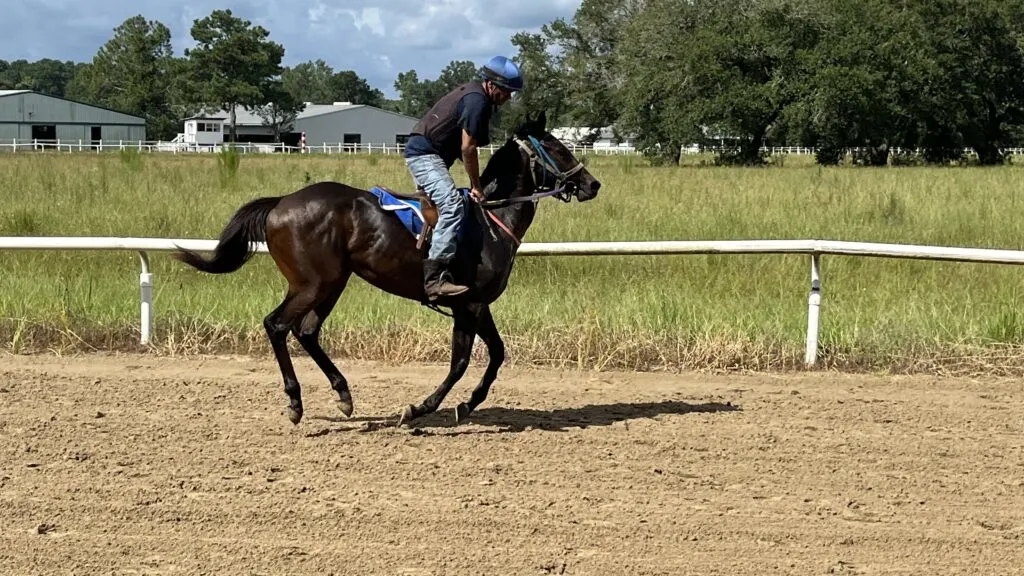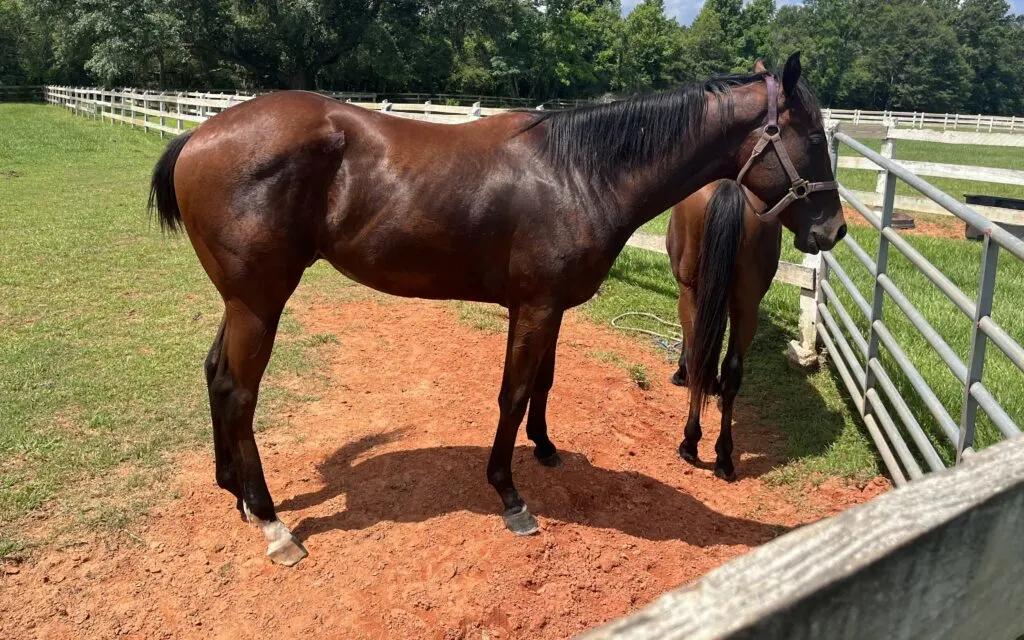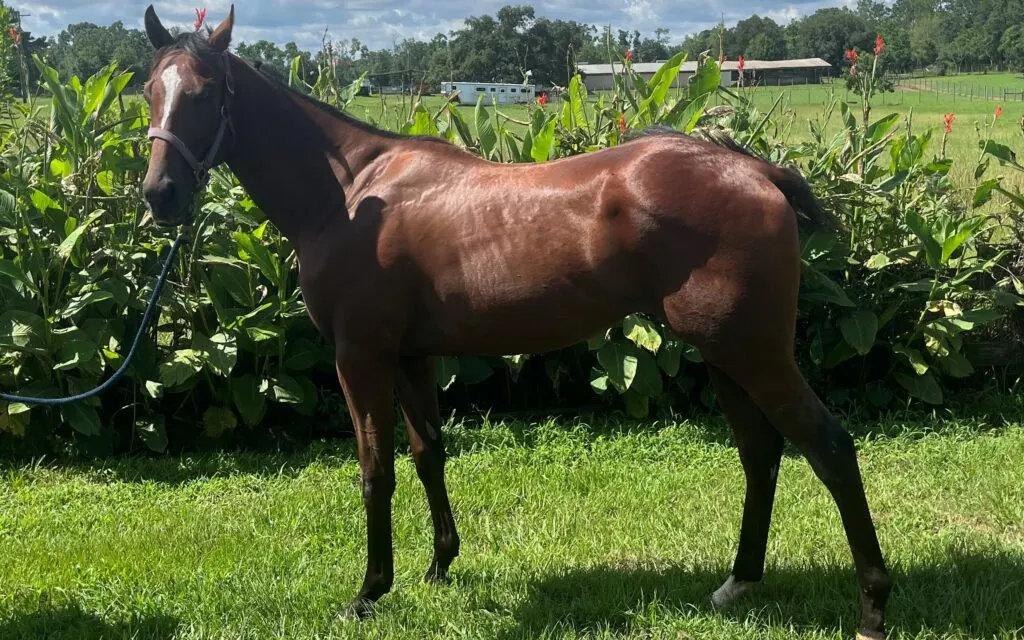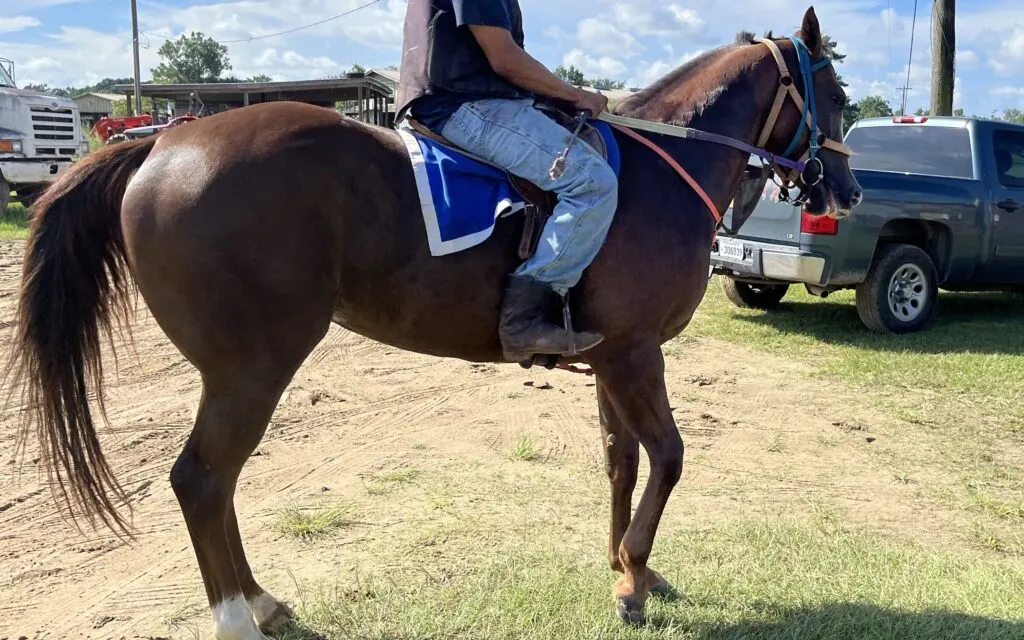Last updated: April 16, 2023
Any links on this page that lead to products on Amazon are affiliate links and I earn a commission if you make a purchase. Thanks in advance – I really appreciate it!
I took my family on a tour of the barns after we watched some young horses work at the training center. While there, our youngest child asked why a groom was running cold water over a horse’s lower legs – the trainer told us the horse bowed a tendon, which raised even more questions.
A ‘bowed tendon’ is swelling in a horse’s lower leg tendon. This condition is typically caused by overworking or chronic stress. There are various degrees of bowed tendons; however, most horses fully recover within a year with rest and treatment.
When the muscles and tendons in your horse’s legs are pushed beyond their limits, they break down, and one of the most common results is bowed tendons. This injury frequently occurs in performance horses used in high-intensity equine activities such as racing, jumping, and barrel racing.

In this guide, we will cover the following:
- What is a bowed tendon?
- What are its causes?
- How it is treated?
- And more…
What is a Bowed Tendon in Horses?
What do famous horses like Seabiscuit, Snowbound, Idle Dice, and Aldaniti have in common? Well, they were all victims of bowed tendons. After Seabiscuit was injured, the vet wasn’t certain he would be able to race again. But he made a full recovery and kept on winning. However, a bowed tendon is one of the most common ‘modern cripplers’ of racehorses.
A bowed tendon is an injury to a horse’s lower leg which is the result of a tearing of the superficial flexor tendon – a longitudinal proteinous structure that connects the muscles above the knees to the pastern bones. It causes pain, swelling, and inflammation resulting in an ‘outward curving’ of the tendon.
When you hear about horse-related injuries, it’s usually something like bowing tendons or muscle tearing. These injuries occur when too much stress is placed on a horse’s legs during intense activity such as racing.
Because leg injuries are the most common type, people often think horses’ legs are fragile. However, that’s not necessarily true; humans often push horses beyond their limits, resulting in leg injuries, such as a bowed tendon.
The tendon fibers are elastic, but when they’re stretched, they tear. The majority of such tearing occurs halfway between the carpus and the fetlock. I’ve only seen bowed tendons in a horse’s foreleg, although it can also occur in their hind legs.
Clinical signs
The most common symptoms of bowed tendon include:
- Pain and limping – A ‘bowed horse’ might come out of the race or workout in obvious pain. It will limp to relieve pressure on the back of the third of the metacarpal region.
- Heat and swelling – since the tendon is torn, it may bleed internally. This leads to heat, pain, swelling, and inflammation. There may be a bowed appearance in the tendon area.
- Changes in walk – A horse with a bowed tendon will walk abnormally on a tipped toe.
- Lameness – in the advanced stage, the horse might become lame.
An alert rider can catch these signs before the tendon is completely torn. In its early stages, the bowed tendon causes the horse to be slightly off in its stride. An experienced exercise jockey can feel the slightest misstep in a horse’s movements.
If you palpate the leg along the superficial flexor tendon, you might feel a slight increase in the skin temperature. This is a surefire sign of the beginning of a bowed tendon, although ultrasound can give you a much clearer diagnosis. The slight increase in temperature indicates inflammation when fibers are torn on the back surface of the tendon.

What are the Causes of a Bowed Tendon?
A horse’s tendon is a tough band of fibrous tissue that connects muscle to bone. The tendons in the horse’s legs are under a lot of stress, and they can be easily damaged by overuse or injury. One of the most common problems affecting horse tendons is “bowed tendons.”
This condition occurs when the tendon becomes irritated and inflamed, causing it to swell and bulge. In severe cases, the tendon can rupture, causing the horse to go lame. Several factors can contribute to a bowed tendon, including genetic predisposition, poor shoeing, and incorrect conditioning.
In order to prevent this, it is important to work with a qualified veterinarian and follow a sound management program. But despite precautions, sometimes, bowed tendons are unavoidable. Most bowed tendons result from hyperextension of the fetlock joint, usually when competing, and are often associated with fatigue. Here are the main causes of bowed tendons:
Fatigue
James R. Rooney, the author of The Lame Horse, has an excellent explanation for bowed tendons. The author blames fatigue as the most common culprit of equine tendonitis. When a horse tires, its muscles in the foreleg tire as well.
If a fatigued horse is ridden at a high speed, all its weight is placed on the leg. Just as its foot touches the ground, the horse’s flexor tendon relaxes and loosens since the tired muscles are not pulling on it as hard as they should. As the load keeps coming on the leg, the flexor tendon snaps.
This is the main reason why bowed tendon is commonly seen during training and workout or when horses have just started racing. Their muscles are just not strong enough to take the load.
Tendonitis is also more common during the summer or warmer months as horses are more fatigued due to the heat. This also explains why horses that race/ride during the night are less likely to suffer from bowed tendons since fatigue is more during the heat of the day.
Surface
Another factor that can significantly increase the load on the tendons and cause tears is the surface the horse is ridden on. Mr. Rooney blames surfaces that take hold and then break away suddenly, such as sun-baked sand.
Such surfaces appear to hold at first and then suddenly break as the weight increases. This causes an improper leg positioning in proportion to the horse’s body weight.
Repeatedly riding on such surfaces causes the strain in the tendons to increase steadily. Remember: this is happening at very high speeds, so acceleration and force also come into play. All these factors cause uneven footing, poor conformation, and unbalanced loading of the tendon – eventually resulting in tears.

How To Treat a Bowed Tendon in Horses?
If you suspect your horse has a bowed tendon, it is important to seek medical help immediately. If caught early, it is curable, and many horses have even gone on to race or perform again. Your vet will conduct an ultrasound on the horse’s affected lower leg.
This will help them assess the severity of the condition. Severely bowed tendons will have tears, while mild cases will only show mild swelling or enlargement. In an ultrasound, a normal tendon will appear white or bright colored, whereas a swollen or torn one will appear in shades of gray or black.
Mr. Rooney further states that many people fail to act when tendonitis is in its early stages. This is a big mistake. He urges horse owners to seek veterinary help at the first sign of heat and swelling in the tendon. Here are the things you should do if you notice the early signs of a bowed tendon:
Quit working your horse
Avoid working your horse and rest its leg completely. All tendon injuries need long periods of rest – sometimes up to twelve months. You can make your horse walk around a bit, but stall rest is important. At all costs – avoid speed work until the swelling subsides completely.
This will usually take a month or longer. (Even if it subsides, please consult your vet before taking your horse out). Remember: If you take your horse to work right away after the initial signs of swelling and heat, it will surely result in a full-blown, torn tendon.
Icing
Icing can help reduce swelling and heat in the early stages of tendonitis. You can use special buckets filled with icy water or horse-soaking boots for the task.
Pain-relief medication
Anti-inflammatory drugs like phenylbutazone can help in relieving pain and soreness. Equioxx or flunixin meglumate are some other NSAIDs that are known to relieve pain and swelling effectively. For tendons that are torn, vets prescribe a drug called Bapten which heals the tears and also strengthens the tendons.
New therapies
There are several newer therapies for treating bowed tendons in horses. These include plasma therapy or stem cell injections and shockwave therapy. However, it is important to discuss these treatments thoroughly with an experienced vet, as some may not be effective for your horse’s case and could even delay its healing.
Alternative treatments like electromagnetic therapy, acupuncture, and hydrotherapy could help with pain management to some extent.

How to Prevent Bowed Tendon?
Prevention is always better than cure regarding a bowed tendon in horses. Here are some ways to prevent it:
1. Hoof Care
You want your horse’s hooves trimmed so it hits the ground correctly. Horses with long toes or low-cut heels cause undue stress on their ligaments. Only use a trained farrier to care for your horse’s feet.
2. Ensure your horse is conditioned properly and fit for its task.
Horses can suffer from a variety of different injuries when they are not in good physical condition. The most common cause is an inadequate workout routine, which leads to underdeveloped muscles, tendons, and bones. A horse not conditioned properly is at a high risk of bowing a tendon during workouts.
3. Avoid ‘iffy’ surfaces
Never ride your horses on sun-baked surfaces, especially at a fast speed. If you must, always walk your horse on these surfaces.
Always ensure that your horse is shod properly. Ride sensibly on a surface with good footing that isn’t too slippery, deep, or muddy.
4. Avoid fatigue
Racehorses usually develop bowed tendons during training and in the first few races. This is because their tendons are not ready to go at full speed. Riders must learn to recognize the signs of fatigue in their horses. These include:
- Lack of motivation
- Slowing down of pace
- Labored breathing
- Inability to jump
Vets recommend the following tips to reduce fatigue in performance horses:
- Adequate physical training over the months leading to the event and a proper warm-up before the actual event.
- Adequate hydration
- Fat supplementation.
5. Avoid speed work during the hot parts of the day
Wherever possible, avoid overworking your horse during the hot months and in the daytime, especially in summer. This is very important to avoid fatigue and exertion of the tendons.

How Bad is a Bowed Tendon Injury?
In its early stages, a bowed tendon is not a serious ailment. However, depending on the severity, it requires a layoff from speedwork and training for about 3 weeks to 6 months.
Failure to rest your horse can result in repeated severe strain on the tendons and could cause the fibers to rupture. If you return your horse to work or racing too soon, tendonitis can become a chronic issue and make your horse ‘unsound.’
Please remember that tendonitis has a very slow recovery, so you must be patient. Always consult your vet and follow his/her advice before working your horse again.

Can a Horse Recover from a Bowed Tendon?
Some horses can fully recover from a bowed tendon, but it depends on the horse, the severity of the injury, and the treatment it gets. The pain, heat, and swelling will subside in mild cases with anti-inflammatory drugs and time off from training.
Remember that tendon healing is a very slow process. If you do not rest your horse adequately, it may re-injure the tendon and set back your horse longer. So, discussing a rehabilitation plan with your vet is very important.
Your vet might schedule repeat ultrasounds to determine the degree of healing. They will then recommend icing or cold hosing along with topical medication. This may be followed by some mild exercise like a few minutes of jogging, walking by hand, or turnout in an enclosed area.
Your horse will need repeat ultrasounds so your vet can assess its improvement. If satisfied, they may recommend increasing the exercise gradually over the period of the next few weeks. It’s essential you get your horse in peak condition before returning it to full competition.
We had a nice filly that won a few good races and then bowed a tendon. We immediately called a vet and followed his treatment plan. She was off for a year before we returned her to training. Her tendon swelled again after her return to training, and she never raced again, but we did use her for a broodmare.
Below is a helpful YouTube video about bowed tendons.
Here is a YouTube video about bowed tendons you may find helpful:
Key Takeaways
A bowed tendon in horses occurs due to swollen or torn superficial flexor tendons. It can cause pain and limping gait in the affected horse. Any horse can develop a bow in its tendon, which is more commonly seen in younger racehorses.
Common causes of tendonitis in horses are fatigue and speedwork on sandy or poor turfs. In any case, the best treatment is adequate rest (up to a year in some cases) and icing, and pain medication. I hope this brief guide helps you prevent bowed tendons in your horse.
FAQs
Can you ride a horse with a bowed tendon?
Yes, horses can still be ridden even if they have a bowed tendon as long as it is not causing them pain. However, it’s best to have a bowed tendon evaluated by a veterinarian to determine the severity of the injury and whether or not the horse can still be ridden.
Would you buy a horse with bowed tendons?
Veterinarian Rick Mitchell, DVM, states that buying a horse with bowed tendons is okay, but only after you ensure the bow is over a year old. And despite that, you still need to have a vet evaluate the bow and follow a careful legging-up process before working the horse.
Do You wrap a bowed tendon?
Some vets recommend using bandage wraps to reduce the swelling. However, in some cases, very tight wraps or bandages could aggravate the bow. So, it is best to follow your vet’s advice.
Will a horse become lame due to a bowed tendon?
Not all bowed tendons lead to lameness, and slightly bowed tendons aren’t even noticeable. However, it is very important to rest your horse when you first notice the bow and have it examined by the vet immediately. This can prevent many complications.
Meet Miles Henry
An avid equestrian and seasoned racehorse owner, Miles Henry brings his extensive experience to the equine world, proudly associating with the AQHA, The Jockey Club, and various other equine organizations. Beyond the racetrack, Miles is an accomplished author, having published various books about horses, and is a recognized authority in the field, with his work cited in multiple publications.
🔗 Connect with Miles:
Twitter
Facebook
YouTube: Check out race highlights, horse care tips, and more!

